
What risks can arise when working in excavations?
Work performed in excavations (earth and trenching work) is considered particularly hazardous in construction industry. In particular, the danger lies in the potential for partial or complete collapse of excavation walls. Risks associated with working in excavations include:
- a person falling into the excavation from an unsecured edge;
- being covered by soil/burial of a person due to excavation wall collapse, often with fatal consequences (the pressure of the soil during the burial is enormous, the soft tissues, arteries and veins in the body are compressed and even if the rescued person is relatively unharmed, a blood or fat clot can subsequently be released leading to embolism and subsequent death – medical attention must always be sought after the burial!);
- objects/machinery falling on a person in the excavation;
- electric shock from damaged electrical wiring;
- gas poisoning from damaged gas pipelines or from rocks;
- damage to structures by gas explosions caused by damaged gas pipeline.
The following happened: occupational injury to a foreigner while working in an excavation with fatal consequences
An employee from Ukraine (†38) was performing manual cleaning of the excavation. The machine-dug excavation measured 2 x 3 meters and was approximately 2.5 meters deep. The fire pipe was to be repaired. The employee entered the unsupported excavation, and subsequently the wall of the excavation collapsed, burying the worker. The cave-in caused injuries incompatible with life.
The driver did not properly secure the crawler excavator on a waterlogged slope. It spontaneously slid down and pushed a 2.5 ton gas pipe into the excavation where the affected Slovak national worker was located (†52). The worker was buried by the pipe and sustained injuries incompatible with life.
“Ten Commandments” of safety for earth and excavation work
- Before starting excavation work, the construction documentation must be properly prepared, and, depending on the circumstances, help of a hydrogeologist and structural engineer may be required.
- Entry of persons into the excavation must be minimized. If possible, give preference to no-excavation work or the use of remotely controlled machines.
- The site of the excavation work must be secured against entry of unauthorized persons and against the risk of persons falling into the excavation.
- Crossings and passageways must be installed over excavations. A crossing of at least 0.75 m must be installed over an excavation deeper than 0.5 m on a fenced construction site, provided with:
railing (one side is sufficient for depths of 1.5 m).

The source of the image: Projekt č. TIRSMPSV701 „Inovativní řešení skupiny potřeb v oblasti optimalizace předpisů, postupů a opatření BOZP včetně diseminačních opatření“ financovaný se stání podporou Technologické agentury ČR v rámci projektu BETA.
- Safe entry and exit to and from the excavation must be ensured (ladder).
- The minimum clear width of excavations with vertical walls, into which persons enter, is 0.8 meters.
The excavation must be secured against the potential fall of persons into it. If the barrier does not meet the strength requirements, it must be placed at a distance greater than 1.5 meters from the edge of the excavation. The barrier may be e.g. railing (portable modular), safety signage (at least 1.1 m high), obstacle (at least 0.6 m high), soil from the excavation (stored in a loose state up to at least 0.9 m).
Obrázek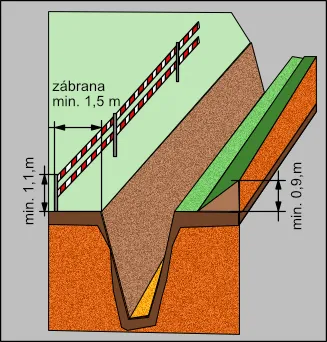 Obrázek
Obrázek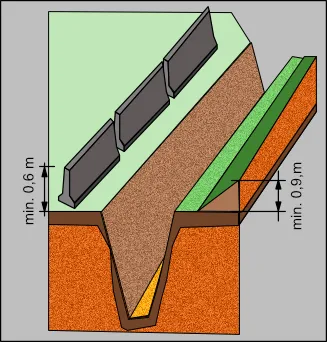
The source of the image: Projekt č. TIRSMPSV701 „Inovativní řešení skupiny potřeb v oblasti optimalizace předpisů, postupů a opatření BOZP včetně diseminačních opatření“ financovaný se stání podporou Technologické agentury ČR v rámci projektu BETA.
Beware of insufficient or missing shoring! There is a risk of excavation wall collapse.
Obrázek
The source of the image: Projekt č. TIRSMPSV701 „Inovativní řešení skupiny potřeb v oblasti optimalizace předpisů, postupů a opatření BOZP včetně diseminačních opatření“ financovaný se stání podporou Technologické agentury ČR v rámci projektu BETA.
The walls of excavation must be secured – e.g. by sloping or shoring.
Obrázek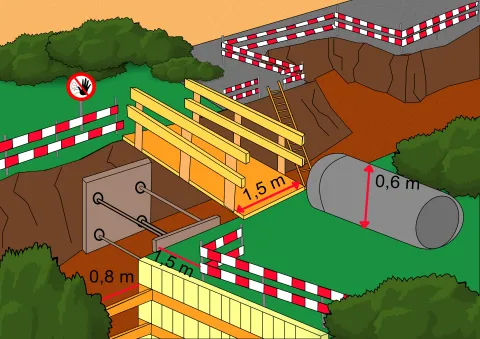
The source of the image: Projekt č. TIRSMPSV701 „Inovativní řešení skupiny potřeb v oblasti optimalizace předpisů, postupů a opatření BOZP včetně diseminačních opatření“ financovaný se stání podporou Technologické agentury ČR v rámci projektu BETA.
The sloping is carried out according to the type of soil, ideally with a slope of 1:1 or 1:2 or less, alternatively, the excavation may need to be stabilized using shoring.
Obrázek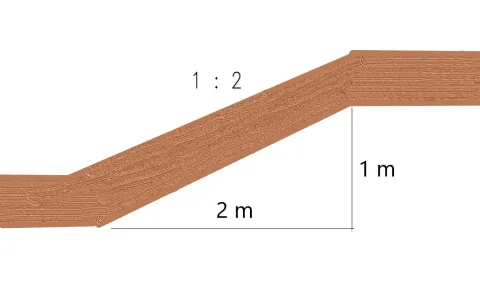
The source of the image: Projekt č. TIRSMPSV701 „Inovativní řešení skupiny potřeb v oblasti optimalizace předpisů, postupů a opatření BOZP včetně diseminačních opatření“ financovaný se stání podporou Technologické agentury ČR v rámci projektu BETA.
Beware of an insufficient sloping angle! There is a risk of excavation wall collapse.
Obrázek
The source of the image: Projekt č. TIRSMPSV701 „Inovativní řešení skupiny potřeb v oblasti optimalizace předpisů, postupů a opatření BOZP včetně diseminačních opatření“ financovaný se stání podporou Technologické agentury ČR v rámci projektu BETA.
- For slopes with a gradient greater than 1:1 and a height greater than 3 m, measures must be taken to prevent the slipping of persons or the sliding of material.
- Undermining the slopes is unacceptable!
For manually dug excavations, the vertical side walls must be secured with shoring: in built-up areas at depths greater than 1.3 meters; in undeveloped areas at depths greater than 1.5 meters. If there is a risk of collapse, shoring is required even at shallower depths!
Obrázek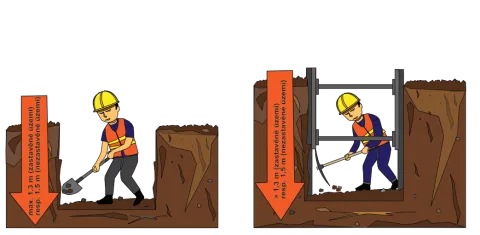
The source of the image: Projekt č. TIRSMPSV701 „Inovativní řešení skupiny potřeb v oblasti optimalizace předpisů, postupů a opatření BOZP včetně diseminačních opatření“ financovaný se stání podporou Technologické agentury ČR v rámci projektu BETA.
- Do not enter mechanically-dug unloaded excavations unless their walls are secured against collapse with a protective frame, safety cage, bracing structures, etc.
- The stability of the surrounding area of the excavation, including surrounding structures (e.g. buildings or roads) must be secured.
Beware of overloading the edge of the excavation with machinery or vehicles! There is a risk of excavation wall collapse.
Obrázek
The source of the image: Projekt č. TIRSMPSV701 „Inovativní řešení skupiny potřeb v oblasti optimalizace předpisů, postupů a opatření BOZP včetně diseminačních opatření“ financovaný se stání podporou Technologické agentury ČR v rámci projektu BETA.
Beware of materials and objects stored near the excavation and in the excavation wall (e.g., boulders, etc.)! There is a risk of them falling into the excavation.
Obrázek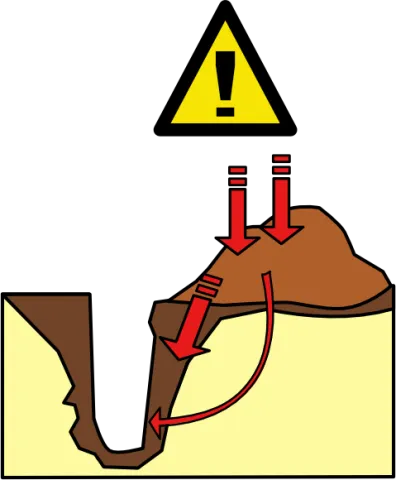
The source of the image: Projekt č. TIRSMPSV701 „Inovativní řešení skupiny potřeb v oblasti optimalizace předpisů, postupů a opatření BOZP včetně diseminačních opatření“ financovaný se stání podporou Technologické agentury ČR v rámci projektu BETA.
Minimize traffic at the edge of the excavation. Do not store materials at the edge of the excavation to avoid overloading. Do not load the edges of the excavation within 0.5 meters of the excavation edge!
Obrázek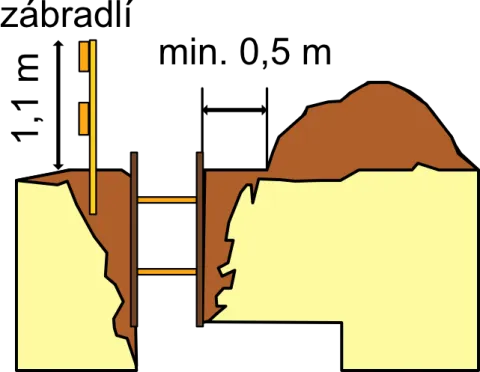
The source of the image: Projekt č. TIRSMPSV701 „Inovativní řešení skupiny potřeb v oblasti optimalizace předpisů, postupů a opatření BOZP včetně diseminačních opatření“ financovaný se stání podporou Technologické agentury ČR v rámci projektu BETA.
.
- All known engineering networks must be marked before starting earthworks.
The removal of soil near engineering networks must be done manually!
Obrázek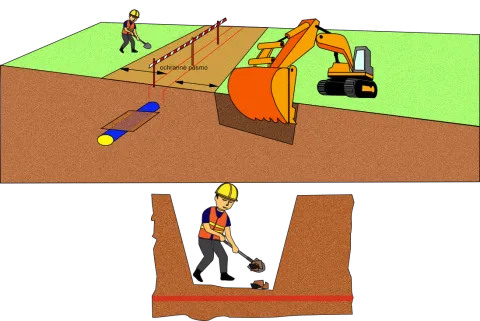
The source of the image: Projekt č. TIRSMPSV701 „Inovativní řešení skupiny potřeb v oblasti optimalizace předpisů, postupů a opatření BOZP včetně diseminačních opatření“ financovaný se stání podporou Technologické agentury ČR v rámci projektu BETA.
- For work carried out in excavations deeper than 1.5 meters, expert supervision is required (e.g. a geologist or geotechnical engineer).
- Beware of vibrations caused by machinery or surrounding traffic. Vibrations can cause the collapse of excavation walls.
- Beware of waterlogging of the slope! There is a risk of excavation wall collapse. If possible, avoid carrying out earthworks when the ground is frozen or after prolonged rainfall.
Do not linger in the danger zone of the machine (e.g., excavator, backhoe, loader, etc.)!
Obrázek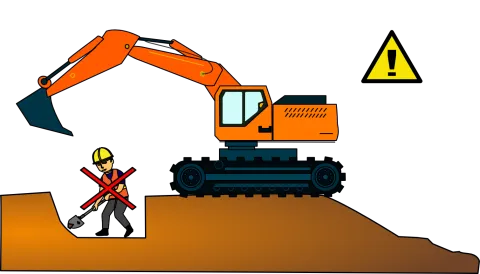 Obrázek
Obrázek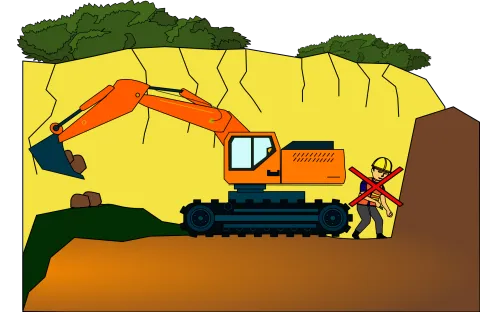
The source of the image: Projekt č. TIRSMPSV701 „Inovativní řešení skupiny potřeb v oblasti optimalizace předpisů, postupů a opatření BOZP včetně diseminačních opatření“ financovaný se stání podporou Technologické agentury ČR v rámci projektu BETA.
The danger zone of the machine is defined by the maximum reach of its working equipment extended by 2 meters; entry into the danger zone is prohibited.
Obrázek
The source of the image: Projekt č. TIRSMPSV701 „Inovativní řešení skupiny potřeb v oblasti optimalizace předpisů, postupů a opatření BOZP včetně diseminačních opatření“ financovaný se stání podporou Technologické agentury ČR v rámci projektu BETA.
- At remote work sites without supervision, excavation work at depths greater than 1.3 meters must not be carried out alone.
For the transport of soil using a wheelbarrow, a sufficiently wide and stable pathway must be established with a slope no steeper than 1:5, without sharp transitions. The road surface must not be slippery and must be reinforced as appropriate.
Obrázek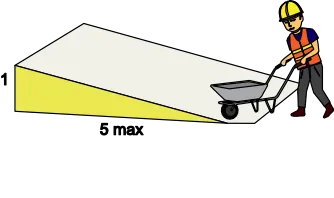
The source of the image: Projekt č. TIRSMPSV701 „Inovativní řešení skupiny potřeb v oblasti optimalizace předpisů, postupů a opatření BOZP včetně diseminačních opatření“ financovaný se stání podporou Technologické agentury ČR v rámci projektu BETA.
For transporting soil with a wheelbarrow to backfill an excavation deeper than 1.5 meters, a sturdy barrier must be installed at the edge of the excavation to prevent the wheelbarrow from sliding in.
Obrázek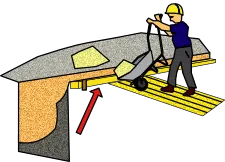
The source of the image: Projekt č. TIRSMPSV701 „Inovativní řešení skupiny potřeb v oblasti optimalizace předpisů, postupů a opatření BOZP včetně diseminačních opatření“ financovaný se stání podporou Technologické agentury ČR v rámci projektu BETA.
- Before the first entry into the excavation or after a work interruption longer than 24 hours, it is necessary to inspect the condition of the excavation walls, shoring, and access points. If necessary, ensure measurement of the concentration of hazardous vapors or gases.
Annex No. 3 III to Government Regulation No. 591/2006 Coll., on more specific minimum requirements for occupational safety and health on construction sites